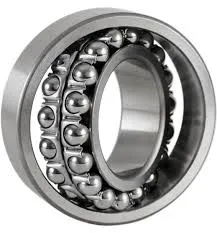
Дек . 04, 2024 04:15 Back to list
how do ball bearings reduce friction in machinery
How Do Ball Bearings Reduce Friction in Machinery?
Ball bearings are essential components found in a multitude of machinery and equipment, ranging from household appliances to industrial machines and vehicles. Their primary function is to reduce friction between moving parts, thereby enhancing efficiency and extending the lifespan of machinery. To understand how ball bearings achieve this reduction in friction, it's important to explore their structure, function, and the physics behind their operation.
At its most basic level, a ball bearing consists of an inner ring, an outer ring, and a series of spherical balls arranged between the two rings. The inner ring is typically connected to a rotating shaft, while the outer ring is fixed in place. The spherical balls serve as the rolling elements that enable smooth motion. This design minimizes the contact area between the moving parts, which is a significant factor in friction reduction.
Friction arises when surfaces slide against each other, creating resistance to motion. In traditional setups without ball bearings, two surfaces can only rely on sliding motion, leading to increased wear and heat generation. When a load is applied, the surfaces may also deform slightly, further complicating the interaction. This results in higher friction levels that can impede performance and lead to faster degradation of components.
Ball bearings, however, introduce rolling motion instead of sliding motion. When the inner ring rotates, the balls circulate around the outer ring, transferring the load evenly and minimizing the contact area. This rolling action creates less resistance compared to sliding, significantly reducing friction. According to physics, rolling friction is typically much lower than sliding friction, making ball bearings an effective solution for reducing energy loss.
how do ball bearings reduce friction in machinery

Another key advantage of ball bearings is their ability to distribute loads. When a force is applied, the design of the bearing allows the load to be shared among multiple balls, reducing the stress on any single point. This load distribution not only aids in lowering friction but also contributes to increased durability. Machinery experiences less wear and tear, which means reduced maintenance costs and extended operational periods.
Moreover, ball bearings come in various sizes and materials, enabling their use in a diverse array of applications. For example, miniature ball bearings can be found in electric motors and hard drives, while larger bearings are utilized in automotive and aerospace industries. The choice of materials, such as steel, ceramic, or plastic, also affects the performance characteristics of ball bearings, including their resistance to heat, corrosion, and wear.
The operational efficiency gained through the use of ball bearings plays a crucial role in energy conservation. Reduced friction means that less energy is required to overcome resistance, which translates to lower energy consumption. For industries that rely on heavy machinery, this can result in significant savings on energy costs and a reduced carbon footprint, contributing to more sustainable practices in manufacturing and production.
Additionally, ball bearings contribute to the smooth operation of machinery, which is essential for precision applications. In industries such as robotics, aerospace, and automotive manufacturing, the accuracy of movement is critical. Ball bearings enable high-speed rotation and precise positioning with minimal backlash, ensuring that machines perform their functions reliably and effectively.
In conclusion, ball bearings are a fundamental innovation that significantly reduces friction in machinery. By utilizing their design to convert sliding friction into rolling friction, they not only enhance efficiency but also improve durability and performance. Their versatility in size and material further extends their applicability across numerous fields. As industries continue to seek ways to improve performance and reduce energy consumption, the role of ball bearings will undoubtedly remain paramount in the ongoing evolution of machinery and technology. Their contribution to reducing friction is not just a mechanical advantage, but a necessary component in the pursuit of innovation and sustainability.
Latest news
-
Premium Deep Groove Ball Bearings | High Speed & Reliability
NewsAug.29,2025
-
Durable Scaffolding Clamps - Secure & Reliable Tube Connectors
NewsAug.28,2025
-
Common Failures in Thrust Ball Bearings and Solutions
NewsAug.22,2025
-
How Tapered Roller Bearings Can Take Shock Loads
NewsAug.22,2025
-
Angular Bearings in High-Precision Spindles
NewsAug.22,2025
-
The Impact of Misalignment on Cylindrical Roller Bearing Performance
NewsAug.22,2025
